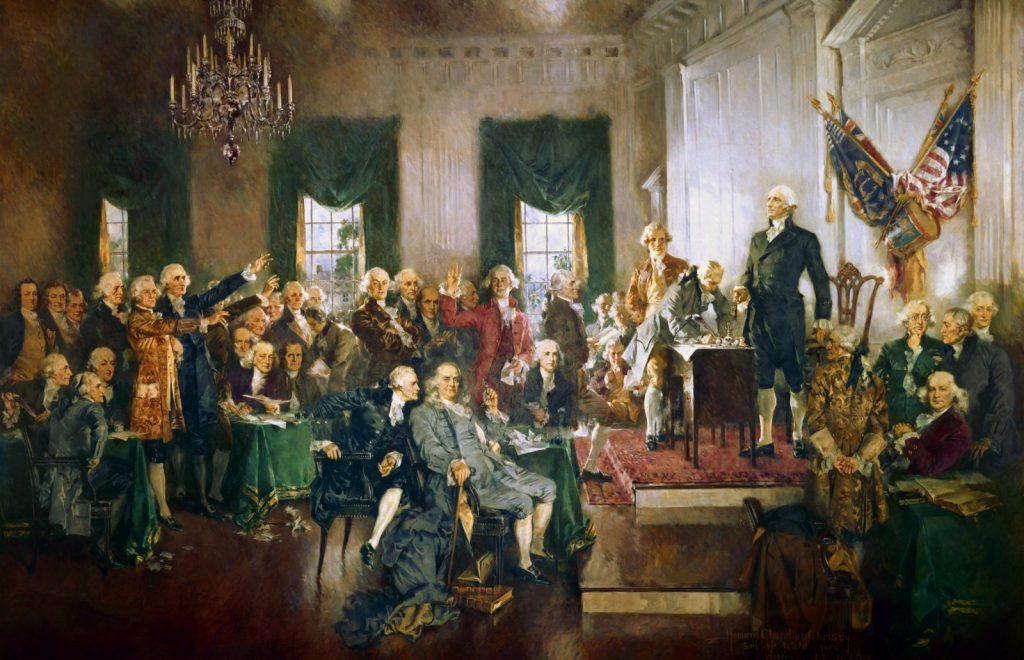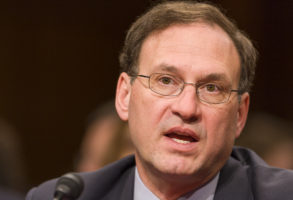
Published April 12, 2019
National Review - April 8, 2019 issue
America’s constitutional order is under siege in the Trump era, according to many observers. As long as the Republicans retain their current win-at-all-costs orientation and remain politically competitive, New York Times columnist Paul Krugman writes, “we will be one election away from losing democracy in America.” Former secretary of state Madeleine Albright felt moved by President Trump’s ascendance to write a book titled “Fascism: A Warning.” Harvard political scientists Steven Levitsky and Daniel Ziblatt did her one better with the title “How Democracies Die.”
These worries about our country’s constitutional future have mostly had to do with how the president has spoken about our system of government, though in just the past few weeks, Trump’s actions have also given constitutionalists something to worry about.
Having failed to get Congress to fund the construction of more sections of a wall at the southern border, the president moved to declare an emergency and repurpose toward wall funding some money that Congress had allocated elsewhere. This declaration has led to a revival of charges that Trump harbors authoritarian tendencies, that he’s a would-be tyrant, or that he otherwise threatens the Constitution.
His emergency declaration is in fact highly objectionable and surely does fly in the face of our constitutional order. It was so disconcerting that many conservatives not otherwise inclined to criticize Trump did so in this case, including some in Congress. In the House, 13 Republicans joined the Democrats in voting for a resolution of disapproval that would have rescinded Trump’s declaration. Twelve Senate Republicans did the same, enabling the resolution to pass and forcing Trump to veto it. Some other Republicans felt it necessary to issue labored explanations making it clear they were uneasy with the president’s power grab even if they could not bring themselves to vote against it.
Liberal observers have been all the more critical, of course. At Slate, William Saletan argued that by siding with Trump, most congressional Republicans failed in their constitutional duty. Trump was acting, he wrote, “in defiance of the express will of Congress.” By letting him do it, Republicans showed that there is indeed a national emergency. “But the threat isn’t coming from Mexico. It’s coming from the Republican Party.”
Saletan has a point. This kind of dereliction, in furtherance of Trump’s counter-constitutional emergency declaration, is indeed a threat to our constitutional order. But it is far from the only threat, and Republicans are not the only reason for constitutionalists to be alarmed. The Democrats are at least as much of a danger to our constitutional order. And they’re becoming more of a danger with each passing day.
Liberals not only disagree with this assessment; they can’t quite fathom it. And therefore they can’t quite grasp why more conservatives who share some of their serious concerns about the Trump-led Republican party won’t simply defect and support the Democrats — at least for a time, until the danger passes. They think the reluctance of conservatives to do this must be evidence of a weakness of will, or of blinding partisanship, or of bad faith. But it’s this very inability among liberals to grasp the concerns of conservative constitutionalists about today’s Democrats that suggests some partisan blindness.
To see the threat that the American Left poses to constitutionalism, we might begin with the very case that liberal critics make against President Trump’s emergency declaration. Saletan, for example, does not make a technical legal argument about the National Emergencies Act of 1976. He makes the point that what Trump is doing is an abuse of the core logic of the constitutional system.
But that very case applies in just the same way to some of what President Barack Obama did on immigration enforcement, especially his policies of Deferred Action for Childhood Arrivals (known as “DACA”) and Deferred Action for Parental Accountability (“DAPA”). President Obama asked Congress to take action, Congress declined to act, and the president then acted on his own in frustration. There were some liberal misgivings before Obama acted — including some expressed by the president himself — but once he did, everyone on the left fell in line. Hillary Clinton campaigned in 2016 saying she might go yet further. Even the kind of modest rebuke that Trump received from some members of Congress in his own party was nowhere to be seen in the case of Obama. For a cause they cared about, liberals were perfectly willing to put aside any constitutional scruples.
But the tension between today’s Left and the Constitution goes beyond these episodes. In recent years, the Left has more and more openly opposed basic features of the constitutional structure that protect pluralism and block large factions from imposing their will on everyone else. Frank rejections of the Electoral College, of the equal representation of states in the Senate, and of religious liberty are becoming ever more normal among Democrats. Some on the left discovered a previously unarticulated love of the filibuster and states’ rights once Trump got elected, but it is perfectly clear that these are purely situational preferences — a constitutionalism of convenience, and barely even that.
The top priority of congressional Democrats upon retaking control of the House this year, for instance, was H.R. 1, the so-called For the People Act. Among numerous other constitutional problems, including violations of the First Amendment’s free-speech protections, that bill would put the administration of elections, voter-qualification decisions, and the drawing of congressional districts into federal hands, in direct contravention of several constitutional provisions.
The weakening of Congress’s powers, a main cause of the growing dysfunction of our constitutional system, is evidently very welcome on the left. Liberalism has grown increasingly inclined to favor legislation that hands blank checks of discretionary authority to the executive branch. That was the case with Obamacare and the Dodd-Frank financial-regulation overhaul, neither of which was traditional legislation in the sense of the New Deal or Great Society programs (however they may have offended conservatives on size-of-government grounds). It would surely be the case with the Green New Deal and Medicare for All.
Liberalism has also grown increasingly inclined over the years to regard political accountability for government agencies as a neutering of them. The Consumer Financial Protection Bureau, a creation of Dodd-Frank, is Exhibit A for this point. It is funded by the Federal Reserve, not Congress, but independent from both: an institutional structure that gives the CFPB power at the expense of accountability. The heads of other government agencies have, unsurprisingly, asked for similar arrangements to be made for them, and the progressive logic behind the CFPB — agencies have to be insulated from political pressure to act as watchdogs — will surely be applied again.
Progressives are also as committed as ever to a view of judging that collapses the legislative and judicial roles into each other, and they have been friendly to such a view even in the Trump years provided that the judges involved have put obstacles in the way of Republican measures. Conservative judges sometimes err, needless to say, but they are at least committed to something much closer to a sound understanding of the Constitution and the proper role of the courts under it.
The Democratic party’s view of judging is now more or less organized around the proposition that the Supreme Court must continue to keep state governments from affording legal protection to unborn children: around, that is, reading into the nation’s fundamental law a denial of human equality and democratic rights that isn’t there. Progressives also want the Court to supervise the drawing of legislative-district boundaries to prevent conservatives from deriving any benefit from their geographic dispersion. They want the Court to abolish capital punishment regardless of public opinion, legislative decisions, and the text of the Constitution. At the same time, they want the Court to retreat from enforcement of provisions that are actually in the Constitution, such as the right to keep and bear arms.
All of these views, and so this overall relationship to the constitutional system, have gained prominence in progressive politics in recent decades, and there is no reason to think they have changed in the Trump era. This leaves conservative constitutionalists, including those who are worried about some of what the Trump administration is up to, with no real reason to place any hope in Democrats.
In September 2016, just a few weeks before the election, we wrote in these pages that Hillary Clinton and Donald Trump posed different kinds of threats to the constitutional order, but that the threat represented by Trump might at least be mitigated by his own mercurial nature. That has been largely borne out.
Trump hasn’t done much to expand presidential power or to threaten civil liberties — but then, and contrary to the views of some of his biggest fans and foes alike, he hasn’t done much, period. He has on several occasions acted in ways that reduced the executive branch’s authority: rescinding Obama’s orders on immigration, halting some Obamacare subsidies that have dubious statutory grounding, and supporting legislation to require congressional approval for major regulations.
When his policies have run close to the constitutional line or crossed it, as with early versions of the travel ban, he has in practice accepted court decisions against him. The emergency declaration for border-wall funding has been the first real practical instance of his violating the essential structure of the constitutional order. In this formal sense, Hillary Clinton would likely have been a far greater menace to the Constitution than Trump has been.
On the other hand, Trump has eroded some norms that buttress constitutional government. A president should ordinarily refrain from commenting on the operations of law enforcement, should encourage respect for the judiciary, and should not come within a thousand miles of flirting with political violence by his supporters. Some of Trump’s conduct in this regard has no precedent in the Obama era or before and has been truly egregious.
Trump’s inability to perform, or apparent lack of interest in performing, much of the traditional job of the presidency is also a small-c constitutional problem for his underlings, for legislators, and for citizens. (Aides have to decide which of his statements are meant as serious orders, for example.) And he has shown an implacable ignorance of the structure and proper functioning of the constitutional system. The president seems to identify our institutions fully with the people in charge of them and to think in personal rather than institutional terms. With respect to this kind of open subversion of norms, Trump has been worse than Hillary Clinton was likely to be.
But norm subversion begets more norm subversion, and so this vice too has been bipartisan in the Trump era. The refusal of some on the left to accept the legitimacy of a duly elected president and the open encouragement of bureaucratic resistance to his agenda, for instance, also undermine the political culture that the Constitution requires.
In our 2016 article, we concluded that constitutionalism had no champion in the presidential election, so that friends of the Constitution had no obvious candidate to support. That conclusion, too, stands.
Through much that he says and also some of what he does, Donald Trump certainly poses a meaningful threat to our constitutional system. Friends of the Constitution should not ignore this fact or push it to the side. But now, as before Trump’s election, the Democrats who oppose him pose a more concerted and comprehensive threat to that system. They do not offer a viable alternative to defenders of constitutionalism. To see Trump (or his party) as a singular disease within an otherwise basically healthy constitutional order would be to misunderstand the challenge.
Recognizing this will not make the work of today’s constitutionalists easier. We still have no good options among the politicians and should be careful not to pretend otherwise. But the health of our constitutional system is not revealed by how people answer a yes-or-no question about Donald Trump.
A healthy constitutional system would certainly benefit from a better president. But it would also require an appropriately assertive Congress and judges who understand their proper role. Above all, and in order to make any of this possible, it would benefit from citizens more eager to demand allegiance to the Constitution in return for their votes. To simply wait and hope for any of this would be naïve. Bringing it about will require work — both civic education and political action.
Constitutionalists must in the short term maneuver within a depressing political landscape and choose among very unappealing options while also doing the long-term work of restoring a healthy political culture with the Constitution at its center. That work has to begin with an accurate, even if disheartening, assessment of where we are.
This article appears as “The Friendless Constitution” in the April 8, 2019, print edition of National Review.
Ramesh Ponnuru is a senior editor for National Review, a columnist for Bloomberg Opinion, a visiting fellow at the American Enterprise Institute, and a senior fellow at the National Review Institute. Yuval Levin is the editor of National Affairsand the Hertog Fellow at the Ethics and Public Policy Center.








